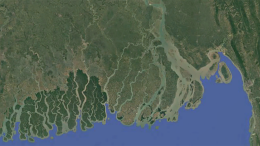Sustainable management of water resources requires data and information on the many areas including availability, access, and use of water resources. In the context of water scarcity in many regions and increasing trend in hydro climatic disaster including flood, landslide, drought in other regions, access to adequate information is critical to understanding and managing the problem of water security and risk. To optimise the use of water, addressing the access and equity in water demand and use, reducing gender gaps in water use, assessing, and managing risks related to water resources, water managers need access to relevant information, data, and analytics to support decision making.
Though the applications of disruptive technologies, i.e., big data, Artificial Intelligence (AI), cloud computing, and blockchain, were confined to the information technology sector before 21st technology, now these disruptive technologies are part of emerging solutions in almost all the development sectors. For water managers/engineers, policymakers and researchers, disruptive technologies are showing promise in many water-related applications such as planning optimum water systems, detecting ecosystem changes through big remote sensing data and geographical information system, forecasting/predicting/detecting natural and human made calamities, scheduling irrigations, mitigating environmental pollution, studying climate change impacts, etc.
This project focuses on application of remote sensing, GIS, big data, AI, and machine learning to assess past, present, and future trends hazard and risk of hydroclimatic disaster, changes in water resources and quantification of water security indicators and water cycle components and develop web enabled application and tools to address the data, information, and knowledge gaps in the water sector for strategic water planning and management. These applications and tools will use open data repositories, open-source computing, AI models and cloud computing platforms to ensure the technology transfer to the Global South without big cost impact.
In 2020-2021, this project developed a historical flood mapping tool using historical Landsat data. The tool allows mapping of surface inundation for any region of the world between the period 1984-2020. The tool was developed leveraging the power of Google Earth Engine (cloud computing) resources. It enables users to analyse spatial and temporal extent of surface water inundation and download the result for further analysis.
The objectives of the project over the period 2022-2023 are:
- To enhance the earlier developed historical flood mapping tool and develop an associated tool to map flood risk using RADAR and high-resolution remote sensing data and AI
- To develop a tool for surface water change detection using remote sensing and big data
- To support UNU-INWEH water security assessments in various world regions using remote sensing, bigdata and machine learning for water security indicators
- To ensure progress with tools roll-out and use in countries – primarily of the Global South
The tools and services that are the focus of this Project are briefly elaborated below:
1. Enhancement of the historical flood mapping tool and mapping of flood risk using RADAR and high-resolution remote sensing data and AI:
Flood mapping: A flood mapping tool developed and launched based on optical imagery from Landsat data which provided historical surface water inundation maps for selected area and time. Incorporation of freely available RADAR data would be useful to improve the accuracy of the maps. In addition, the current system has a 30m resolution which is good for regional and national level analysis, a higher resolution system would be useful for urban and property level flood risk analysis. The focus will be on i) improving the capability and accuracy of the current flood mapping tool incorporating other satellite data especially freely available RADAR satellite data, and ii) Explore possibility of improving the resolution (using both free and commercial data) of the mapping for local, urban and property level applications.
Flood risk analysis and mapping: The flood risk tool will provide flood risk map for a given area. A framework based on historical flood map generated by flood mapping tool and trained AI model will be developed to analyse flood risk of selected region. The AI model will be trained using open data including land use land cover, population, infrastructure, precipitation, temperature, and gender and age disaggregated socioeconomic data. This module will help identify the most flood-risky areas for the future planning and risk mitigation. Results will be displayed on the screen and can be downloaded for specified areas at a district or city level. This component of the project therefore will aim to:
- To develop a methodology and framework for flood risk mapping
- To develop an online tool for analysing flood risk for selected area.
2. Surface water change detection tool using remote sensing and big data
The surface water change detection tool leverages the extensive archive of Landsat and Sentinel data in the Google Earth Engine archive and Google’s cloud processing power to quickly calculate past patterns of surface water extent from multiple layers of Landsat and Sentinel imagery. The tool will consist of a Google Earth Engine application and a user-friendly web interface that allows the user to specify the period evaluated and other calculation parameters that are then executed in a cloud service. Results will be displayed on the screen and can be downloaded for specified areas. The tool will analyse and produce maps of seasonal dynamics and historical trends in surface water availability in inland water bodies for selected region. The tool will be useful for analysing storage in waterbodies and reservoirs.
3. Remote sensing, bigdata and Machine learning to support water security assessments
Water security is defined as “the capacity of a population to safeguard sustainable access to adequate quantities of acceptable quality water for sustaining livelihoods, human well-being, and socioeconomic development, for ensuring protection against waterborne pollution and water related disasters, and for preserving ecosystems in a climate of peace and political stability”. UNU-INWEH runs a separate project that focuses on quantification of water security in various regions of the Global South. The recent report by UNU-INWEH titled “Water Security in Africa: A Preliminary Assessment” used 10 indicators describing various aspects of water security. In most cases, the issue of feeding reliable data into such indicators was a major problem. Remote sensing may assist in estimation of a range of such indicators, including water availability, water infrastructure, water quality and others. The project will first focus on developing methodology for water quality indicator(s) assessment.




